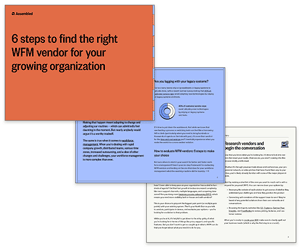Breaks are an essential part of the daily routine in a call centre, but scheduling them can cause a headache for management. Matthew Brown looks at successful methods to overcome lunch and tea break planning chaos.
Lunchtime arrives at precisely the wrong time for many call centres. The early hours of the afternoon are often one of the busiest times of day. When increased call volumes clash with agent break times, it is easy for a call centre to find itself without enough staff on the phones. So how can planners avoid problems? And how can the break-time preferences of staff be catered for whilst dealing with business needs?
Scheduled breaks
Inevitably, it will be impossible to please everyone when scheduling breaks. Several things can be done to cater for agent preferences or, if that isn’t possible, explain to agents why break scheduling is important.

Paul Miller
“The issue of preferences and habit are hard to break but in my opinion a planning team needs the freedom to allocate breaks and lunches and the confidence that the instructions will be followed,” said Paul Miller, Associate Director – Contact Centres at Prolog.
Failing to follow the instructions of a planning team will obviously lead to problems. But at the same time, such a top-down approach will come to be seen as inflexible amongst agents – especially at times when the schedules are adjusted to support other activities in the business.
“It’s far better to explain why agility is important. Most agents don’t see behind the scenes in planning and often don’t understand why it matters,” said Paul Miller.
Accommodating staff preferences
Explaining the necessity of break scheduling can help staff see why their individual preferences may not always be accommodated. Preferences could also be offered as incentives, rather than an automatic entitlement.
For example, agents with outstanding attendance and timekeeping records could be offered first choice of break times. This could help align the agent’s motivations with the needs of the business.
“A team manager who understands why particular agents want to be together at break times can manage the situation well so that the planning team can try to find a degree of compromise, but the same issues can be addressed by matching start and end times and seating plans,” said Paul Miller.
Unscheduled breaks: The DVLA experience
For more ideas on how to deal with break requests, it is worth looking at the policy created by the Driver & Vehicle Licensing Authority contact centre in Swansea. The DVLA contact centre has around 750 full-time employees. Agents answer over one million calls a month. Scheduling breaks effectively is obviously an extensive and important task.
Each agent is given a rota 10 weeks in advance, and 20% of the 10 weeks will be allocated as a ‘reserve’ week, allowing the Resource Planning team to cover any unexpected shortfalls at any time. A workforce management (WFM) solution is also used to schedule and optimise shifts and breaks.
When feedback from agents suggested that they would like more control over their own break times, planners at the DVLA decided to look into a more flexible system of unscheduled breaks. The result was a list of guidelines, reproduced here:
- For a team of 12 staff, a maximum of 3 staff could take a break at a time – so in principle having a similar effect on staffing levels as scheduled breaks
- A bowl of 3 objects was placed on the team leader’s desk. If there was an object in the bowl, there was a space for someone to take one out and go on break. Some of the objects used were tennis balls and spoons.
- Staff were not allowed to take a break within the 1st hour or last hour of their shift
- Staff were not allowed to take a break ½ an hour either side of their lunch
- An agreement was made that staff could take a minimum of a 5-minute break and a maximum of 20 minutes at any time of their daily allocation.
- Staff could only go to break if there was an object available in the bowl on the line manager’s desk.
- As scheduled breaks are removed from agents’ rotas, the agent adherence target needs to be changed to reflect the periods of non-adherence experienced when an unscheduled break is taken.
Trial
These guidelines were trialled in the contact centre. The results were interesting. Firstly, teams found it difficult to plan who was taking a break, due to the ‘object in the bowl’ policy.

Geraint Davies
“Some frustration was seen when trying to get an object from the team leader’s desk, as another agent would beat them to it,” said Geraint Davies, Services Performance Manager at the DVLA Contact Centre.
“The Service Performance Team also found the deviation reports to be inaccurate when trying to plan and forecast the day’s performance.”
“The trial did, however, provide agents with the option of taking a welcome break after a difficult call.”
The results
As a result of the trial, the DVLA found that a system of unscheduled breaks was probably best used on a small scale.
Taking into account feedback from planners, the system was adjusted to operate on a rotation basis. So while one team works with unscheduled breaks for one week, other teams use the traditional scheduled breaks. The unscheduled break option changes to a different team each week.
Having only one team using unscheduled breaks at a time has allowed the resource planning team to forecast and plan the day/week more accurately and allows the teams to plan ahead for their week using unscheduled breaks.
Rotating the unscheduled breaks allows planners to forecast days and weeks ahead more accurately. Teams can also organise themselves in advance of their unscheduled break week, to anticipate any problems and prevent situations in which agents struggle to know when to take their break.
“It’s been such a success that we have adopted a very similar principle when scheduling team meetings,” said Geraint Davies.
The DVLA unscheduled break trial shows that a mixture of scheduled and unscheduled breaks can work. Methods that provide agents with a tangible indication of when they can or cannot take their breaks – such as the ‘objects in a bowl’ system – can also work well once a balance has been found.
How do you deal with break requests in your call centre? Leave a comment in our popular forum.
Author: Jo Robinson
Published On: 9th Nov 2011 - Last modified: 12th Nov 2024
Read more about - Workforce Planning, Absenteeism, Employee Engagement, Motivation, Scheduling, Staffing, Workforce Management (WFM)



















The approach of have 3 objects in a bowl, as per the DVLA experience, does go against WFM methodology. This is the classic “team leader” method of scheduling breaks.
Rather than limiting the number on break, we should focus on how many we need in the queue. These are completely reverse/opposite perspectives and should be seen as a good example as to why net-staffing should be the key point of focus for all.
Very interesting read, how to balance the desire to give more freedom to CS employees yet avoid chaos and ensure that the level of service to customers remains high. Lesson for shop floor employees too?
Very interesting read. Out of all my research so far, this is the only document that has truly shown a method trying to tackle a flexible or unscheduled break system.
Thank you!
Found this article very interesting – was researching some alternative methods to what I currently experience – I have 2 30 min breaks a day, start at 8:00am, and every day my first break is at 11:30 (3.5 hours into the start of my shift) I then work an hour and a half, have my second break, and then work 2 hours before my finish… seemed a bit bizarre as to why I had to wait until almost halfway through my shift for my first break.